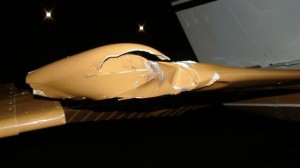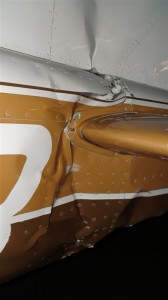Things that Go Bump in the Flight
A recent check of my e-mail inbox brought one of those Yogi Berra “déjà vu all over again” moments: The subject line read “Deer strike – aircraft grounded.”
Two years ago, the bent metal belonged to my flying club’s Cessna 182, which spent the next six months in a hangar to have nearly $35,000 in damage to the empennage and aft fuselage repaired. More recently, the grounded aircraft belonged to the Civil Air Patrol. Damage was minimal this time and, as is the case for many close encounters between aircraft and wildlife, there were no human injuries. Clearly, though, deer aren’t good for the health of pilots or aircraft.
metal belonged to my flying club’s Cessna 182, which spent the next six months in a hangar to have nearly $35,000 in damage to the empennage and aft fuselage repaired. More recently, the grounded aircraft belonged to the Civil Air Patrol. Damage was minimal this time and, as is the case for many close encounters between aircraft and wildlife, there were no human injuries. Clearly, though, deer aren’t good for the health of pilots or aircraft.
 They’re Everywhere. With an estimated U.S. deer population of more than 26 million, it is no wonder that collisions between aircraft and deer are so common. Deer have adapted to human environments, including airports, with predictable results. From 1990 to 2007, more than 760 deer-aircraft collisions were reported to the FAA. Of these, at least 629 indicated the aircraft was damaged in connection with the collision. (Not all damage results from actually hitting the animal; in some cases, the pilot’s evasive action attempts have caused the need for repairs.)
They’re Everywhere. With an estimated U.S. deer population of more than 26 million, it is no wonder that collisions between aircraft and deer are so common. Deer have adapted to human environments, including airports, with predictable results. From 1990 to 2007, more than 760 deer-aircraft collisions were reported to the FAA. Of these, at least 629 indicated the aircraft was damaged in connection with the collision. (Not all damage results from actually hitting the animal; in some cases, the pilot’s evasive action attempts have caused the need for repairs.)
Is Avoidance Possible? Deer are most active in the twilight hours and at night when they feed. So it is not surprising that most airplane/deer strikes occur during this period of reduced visibility. The longer hours of darkness in autumn and winter are prime times for these collisions. A study by Northwestern University’s McCormick School of Engineering and Applied Science provides insight into the “modes” in which an animal such as a deer or a bird could find itself in relation to another object, such as your airplane. The “deliberative” mode most often occurs during day¬light, which provides the ability to see and deliberately avoid moving objects. With less visibility, however, the operative modes are “reactive” or, at worst, “collision.”
What Can You Do? As any pilot (or automobile driver) who has experienced a deer or bird strike can attest, the operative modes – for both humans and critters-during the reduced visibility of twilight and evening hours are the “reactive” and “collision” modes. The typical advice with respect to birds (at least those you can see) is to climb, since the bird’s instinctive reaction is to dive for greater airspeed. In the case of deer, however, there is probably little that you as the pilot can do to avoid collision if a deer decides to make a runway incursion while your airplane is using the asphalt for taxi, takeoff, or landing. But if you hear or feel something go bump in the flight, the most important thing you can do is, as always, fly the airplane. Avoid the temptation to take evasive action that could lead to loss of control. Evasive action attempts can be more damaging – and sometimes more deadly – than impact at relatively low speed.
Though not a preventive action, you can also help by reporting wildlife strikes, including both bird and deer strikes, to the FAA. Reporting collisions with wildlife is crucial to helping the agency use its wildlife strike database for a greater understanding of the problem. You can find FAA Form 5200-7 online, as the FAA now provides electronic filing for wildlife strike reports. In addition, the FAA maintains an Airport Wildlife Hazard Mitigation Home Page, which serves as a good resource for information regarding wildlife aircraft hazards. (FAA Aviation News – JanFeb 2009)
